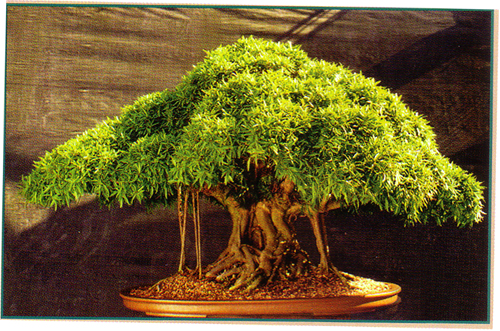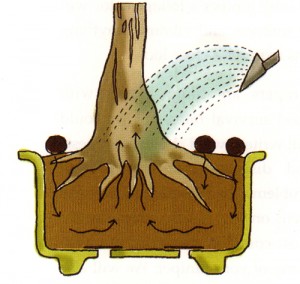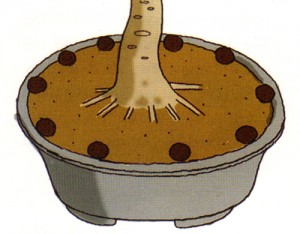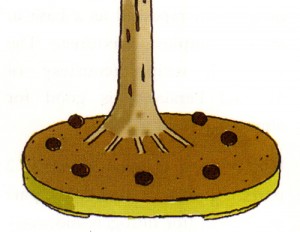 Your bonsai may never look like this, but they can be this healthy. This magnificently robust Willow leaf ficus (Ficus nerifolia) is by Jim Smith of Dura-Stone in Vero Beach Florida. The photo is from Bonsai Today, issue 61 and was taken by Jim.
Your bonsai may never look like this, but they can be this healthy. This magnificently robust Willow leaf ficus (Ficus nerifolia) is by Jim Smith of Dura-Stone in Vero Beach Florida. The photo is from Bonsai Today, issue 61 and was taken by Jim.
Your bonsai depend on you
Bonsai do not survive on water, light, and love alone. Because most bonsai soil has very low nutritive value (if any), your bonsai depends on you for feeding.
Feed generously
Feed generously if you want your bonsai to thrive. The best way to do this is frequent moderate doses during the growing season. Here’s an edited excerpt from an earlier post on the importance of generous feeding:
The perils of not feeding enough
Most people underfeed their bonsai. This may be because they want them to stay small, so they don’t feed much, if at all. What you end up with if you don’t feed enough, may or may not be small, but it WILL be unhealthy.
Healthy trees can take it
Healthy trees take better to the deprivations of small container growing and other insults like severe top pruning, bending, carving and rootpruning, so make sure your bonsai get what they need, especially during the peak growing season from spring through mid summer.

When you use pellets or other solid fertilizers, each time you water, nutrients are washed down into the soil. Illustrations are from our Juniper book.
Organic fertilizers
Many bonsai enthusiasts and professionals swear by organic fertilizers, especially slow release pellets and cakes. Japanese bonsai growers have been using them for hundreds of years with excellent results.
Organic fertilizers are mild (have fairly low N-P-Ks) and tend to have a broad spectrum of macro and micro nutrients.
 When trees are in the pot for a long time, the roots spread to the edge of the pot, so you want to place the fertilizer near the edge; the fine feeder roots that absorb water and nutrients are mostly at the outer reaches of the root system. These fertilizer balls are larger than the pellets we use, so not too many are needed.
When trees are in the pot for a long time, the roots spread to the edge of the pot, so you want to place the fertilizer near the edge; the fine feeder roots that absorb water and nutrients are mostly at the outer reaches of the root system. These fertilizer balls are larger than the pellets we use, so not too many are needed.
Pellets
Organic fertilizers often come in pellets or other solid forms that break down over a period of several weeks, providing a slow steady supply of nutrients as they break down.
 Place the pellets halfway between the trunk and edge of the pot on freshly transplanted trees.
Place the pellets halfway between the trunk and edge of the pot on freshly transplanted trees.
Add new pellets regularly
Because it takes a week or two for pellets to start breaking down, the most efficient way to use them is to add just a few pellets every week during the growing season. This will assure that some are at their nutrient-releasing peak at all times.
 On forest style plantings, spread the pellets around so that each trunk gets its share. Be sure to put some on the inside of the forest.
On forest style plantings, spread the pellets around so that each trunk gets its share. Be sure to put some on the inside of the forest.
Stay posted for future Green Workshops with more on fertilizing and other useful basic bonsai stuff.
sir your bonsai is looking very very beautiful iam mad of bonsai plants and having atleast25 bonsai plants but does not look good please advice me iam from indiaand i want to know how does bougainvilla get full of bloom without leaves in season
Hello Suresh,
For info on your bougainvillea, try this site http://www.burkesbackyard.com.au/2002/archives/2002/in_the_garden/gardening_tips,_books,_techniques_and_tools/how_to_keep_a_bougainvillea_flowering
As far as your other bonsai go, you pose a very large and complex question. It a way, it’s what this blog is about, as well Bonsai Today and other magazines and books. Or perhaps you can find a teacher in your area?
Anyway, good luck!